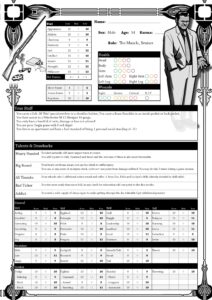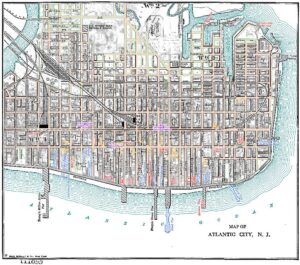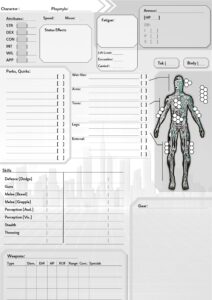This post, rather than a project, concept or game format that I’m working on, is entirely for my own benefit and the further discussion amongst the players of the Afour gaming group. And I’ll be grinding over the rather mundane and geek-rules-lawyer driven concept of role-play character advancement, more specifically – within GURPS.
Why Is This Important?
Well, as a gamer, and – more importantly; as a games master, I have a requirement that my games make sense, so that all involved can better enjoy the game, not only should the system of rules in play make sense, but they should not obfuscate the game-play and of course be fun or rewarding to those involved.
Let me first come to the point of ‘reward’. Fire up the dopamine machine, we all want a sense of achievement, congratulatory celebration or elation it helps us, the players, feel good. And to that end, I believe that a game should offer a rewarding experience. And here’s the kicker, for this to happen, their should ideally be some scale of risk, challenge or adversity against which this reward can be played.
To put it more simply;
“The party is ambushed by orks!” – a challenge.
“one of the orks lands a heavy blow on your character, your wounds so grave you are at deaths door!” – a risk.
“with your final burst of strength you slay the ork and you fall exhausted but victorious… everyone can have 60 experience points!” – the reward.
The third part is made better because of the previous building points and wa-bam, dopamine delivered, sign here.
So? What Does That Have To Do With Anything?
Yup, you caught me I’m rambling… Well, in GURPS, after some research and talking among more veteran players of the system I found an odd part of the rules that I currently disagree with entirely… and as such, will be ignoring/overriding (as is recommended when using GURPS).
My current understanding of the advancement system as per RAW (rules as written) is that it takes 4 points to improve a skill. And, in most cases, it’s 4 points regardless if that skill is denoted as Easy or if it is denoted as Very Hard. And more over, it’s 4 points if the character is marginally average, and it’s 4 points if the character is already at a nearly a peak of their ability.
Instantly; I disagree that a character should advance a ‘Very Hard’ Skill with the same scope of effort (reward) as they would an ‘Easy’ skill. This, to me, makes no sense at all. There is some caveat to this effect; the levels of skill have a decreasing ‘value’ as they are accrued. Nontheless, I firmly believe that to achieve a higher capability a character should face a harder challenge.
My Adjustments In The Format Of Advancement Costs For GURPS
With all that in mind, I shall be using the following ‘home ruling’ as it both makes sense, and ‘feels’ right to me.
For a character to advance one level in a skill, the player must spend points value as costed from that skills base attribute. Each subsequent additional level is to be calculated individually.
Be aware, the following will only make sense to GURPS players!
An example;
Bob, is a builder. He has an IQ of 10, he has a skill level of 11 in architecture, an IQ Average skill.
Bob wishes to become a better builder, he could of course go away, study at college and gain IQ, raising his relevant IQ skills as well… or he can focus on developing just his architectural skill.
Bob get’s paid in skill points (an odd currency and a terrible exchange rate to the Zimbabwean dollar…) he’s saved up 16 points. Good for Bob.
As his skill is IQ Average and is already at +1 compared to his base attribute the new skill to be bought will be at +2, the cost of this will be 8 points. (reference p.170 Basic Set for “Buying Skills”)
Were Bob to decide he wants to become a master builder and aim to improve his skill to be +3 against his base attribute, he would then spend an additional 12 points.
And so, to get from a skill level of 11, to a skill level of 13 would cost, in total; 20 points.
Wrapping Up
“But wait!” I hear literally nobody cry,
“that would cost the same as if he chose to improve his IQ”. Well, Yes.. yes indeed it would, but in my format above, I hope that ‘opportunity cost’ becomes more relevant…
A character with 12 points saved can choose to wait, and save for enough to improve an attribute, but they do so risking NOT having skills in play which may be essential to the characters in-game effectiveness. And more importantly, the concept of sunk cost will be, I’d hope, more pertinent.
If a player is pouring points into a skill they deem essential, the ‘value’ of that skill is a paramount detail… And in due time, the scale at which a skill can be improved begins to become punishingly diminished by how many points it would require; enforcing that no character can heavily min-max, and further reinforcing the idea that a player should perhaps look at other relevant skills to buy/improve to create a more rounded character.
There are pro’s and cons of this method, but until I can see otherwise, I believe that this will offer a challenging and rewarding system of character improvement.
-Rich


 To somewhat protect my effort and work on this, the map is resized here to less than a quarter of the actual size and quality of the final piece I’ve had printed!
To somewhat protect my effort and work on this, the map is resized here to less than a quarter of the actual size and quality of the final piece I’ve had printed!

